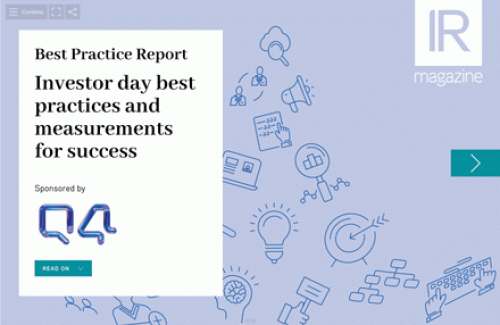For IBM, shareholder engagement is nothing new. Evan Barth, senior counsel at the company, says that when he joined IBM in 2008, there was already a robust proxy season engagement plan in place – long before the term ‘shareholder engagement’ was mainstream.
In March, once the proxy statement has been filed, IBM’s in-season engagement efforts kick in. In 2019 the firm engaged with more than 100 institutional investors, representing more than 70 percent of the company’s institutional ownership, and reached out to more than 250,000 retail investors and registered shareholders.
But it’s outside of proxy season that IBM’s shareholder engagement efforts really stand out. In 2017 the company began a much more concerted off-season engagement campaign, run by the corporate secretary’s office. This year the team started its off-season engagement in September, just a couple of weeks after the proxy meeting, and it ran all the way through until February. During this time, the team met with investors representing more than 30 percent of shares that voted at the 2018 proxy meeting, and contacted investors representing more than 50 percent of shares voted.
The longer this off-season engagement goes on, the more sophisticated it becomes. ‘In the last year we created our own internal database for feedback from each investor [meeting],’ Barth says. ‘We track whether it agrees with our positions or not, and also what its perspectives are. That means we can have a customized approach to our engagement, where investors can meet with different leaders from IBM.’
For instance, if the team knows an investor is likely to ask questions about executive compensation, it will ensure the vice president of compensation and benefits is in the meeting, to enable a deep dive. This strategy reaches right across IBM’s leadership; the team has facilitated investor meetings with IBM’s chair and CEO, lead director, CFO, general counsel, chair of the executive compensation and management resources committee, vice president of corporate and environmental affairs, vice president of corporate citizenship and many others.
Natalie Wilmore, senior attorney at IBM, also points out that the team keeps an eye out for investors’ articles and thought leadership on certain topics that are published outside of meetings. ‘If we see an article by one of our top investors explaining its position on cybersecurity, for example, we will take that to our team to see how it aligns with what we’re doing,’ she says.
One of the key aspects of shareholder engagement is that companies are seen to respond to the feedback they receive. In this spirit, Barth points to an ESG webcast IBM hosted last year for its investors. ‘In the last year we started getting more E and S questions,’ he says. ‘What we found is that people were interested in a deeper dive than we were giving in meetings, so we launched the webcast as an even deeper dive. It’s been wildly successful.’
Wilmore adds that the webcast format allows the team to be flexible with emerging topics that are on investors’ minds. She cites ethics in artificial intelligence as one of those topics that has recently emerged, and that will be addressed in this year’s webcast. Other examples of recent changes discussed during off-season engagement include: changing the title of the presiding director to lead director and adding an IBM revenue metric to the annual incentive program.
Finally, Barth says, it’s important to explain your shareholder engagement efforts clearly in the proxy statement – articulating why it’s important, how it’s done and what the outcomes are. ‘Proxy statements are 90 pages long, but only five pages are read,’ he says. ‘That’s why the shareholder engagement section matters to us.’
This article originally appeared in the latest Corporate Secretary special report.










